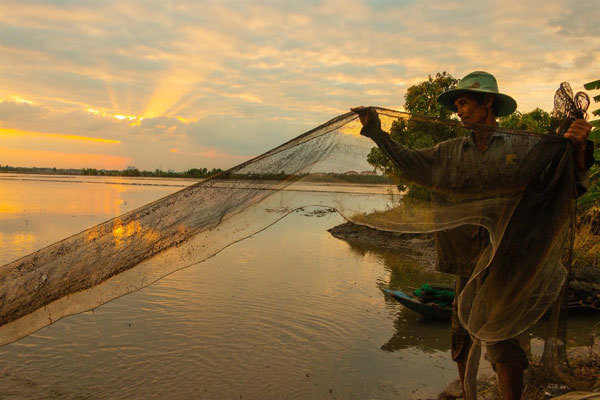 |
| A local catches fish in Hau Giang Province in Vietnam's Mekong Delta. VNA/VNS Photo Duy Khuong |
To his son’s disappointment, when the net is hauled back it doesn’t contain many fish, unlike during Duc’s childhood when he used to follow his father and grandfather.
“When I was small, fish were abundant here. I could have a few buckets of fish after catching for a short while,” said the 41-year-old.
“I am afraid there won’t be any fish left when my son becomes a fisherman,” added Duc, a third-generation fisherman from Nhon Hoi Commune, An Phu District.
His fears are borne out by an investigation that analysed data on the fishery capture, employees working in fisheries and water levels provided by Vietnam’s General Statistics Office (GSO), An Giang’s Department of Fisheries, and interviews with experts and local communities.
Climate change and the operation of hydropower dams upstream have left water bodies dry in An Giang, a wetland area and the first place in Vietnam to receive floodwater from the Mekong, devastating fish stocks and threatening the livelihoods of local communities.
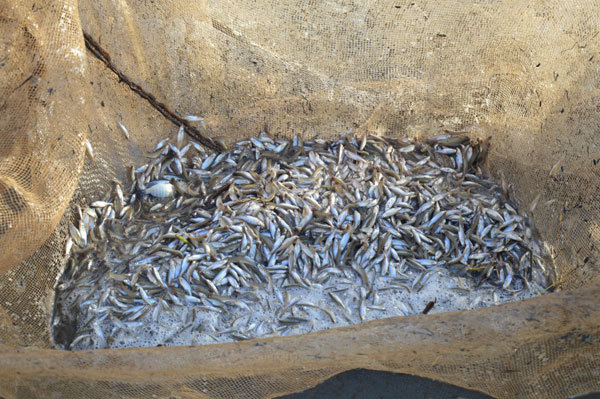 |
| Freshwater fish are running out in An Giang Province. Photo courtesy of Dang Huu Duc |
The river is the lifeline for 60 million who rely on the water for daily use, agriculture and fishing. Nearly one-third of them are in Vietnam.
Between 2000-2020, An Giang lost more than 80 per cent of freshwater fish catches, or more than 76,100 tonnes, equivalent to the average fish consumption of some 3.7 million people in a whole year.
An Giang saw the largest drop but other inland localities in the Mekong Delta, namely Long An, Vinh Long, Dong Thap, Can Tho, and Hau Giang, also experienced a decline. Lower fish stocks are having a detrimental impact on people in the delta.
No more fish
Binh Thien Lake, where Duc and his son have been fishing, is a branch of the Hau River, the first and main distributary of the Mekong River and the beginning of the Mekong Delta in the country.
The lake belongs to an interlaced system of rivers and canals, that are home to a variety of fish species.
About 10km away from Binh Thien Lake, Le Van Khang, a 60-something fisherman from Phu Hoi Commune, An Phu District, also struggles with the decline in fish.
An Giang, the first place in Vietnam to receive annual flooding from the Mekong River
“We are running out of fish. The amount of fish caught now is about a fifth or sixth of that 10 years ago,” he said.
An Giang observed positive growth from 1995-2001, however, since then, it has seen a 9 per cent decline on average every single year.
Of the 10 years which have seen the largest drops in catch, five were from the last decade and two of them were the most recent years, 2019 and 2020.
From a province contributing a great share of the freshwater fishery, An Giang is no longer a bright spot for fish in Vietnam.
In 2000, almost 4 in 10 fish of Vietnam’s inland catch came from this province. Now, it contributes less than 1 in 10.
An Giang may have seen the sharpest drop in fish catch, but it is not alone. All other five inland provinces in the Mekong Delta experienced annual decline rates of 1 to 9 per cent in the 2001-2020 period.
In 1995-2001, the fishery catch from the inland provinces increased but the upward trend has been disrupted since 2001.
In contrast, coastal localities in the delta, namely Tra Vinh, Tien Giang, Ben Tre, Kien Giang, Soc Trang, Bac Lieu, and Ca Mau all enjoyed positive growth in fish caught in the 1995-2020 period.
Climate change, dams and dykes to blame
In recent years, water levels in An Giang have been much lower than they should have been at the peak of the monsoon season in October.
The flood season in the province often starts from mid-June and goes to late November with the peak in September or October, said meteorologist Phan Minh Dat from An Giang Centre for Hydro-Meteorological Forecasting.
The annual flood peaked in 1990-2020 in An Giang area but are now reduced compared to the average levels, especially in the 2011-2020 period. The record low was in 2015, he said.
Data from the General Statistics Office showed that the flood peaks at both Tan Chau and Chau Doc stations in An Giang have gradually declined every year with steeper dips during the droughts in 2015-2016 and 2020.
Officials and experts agree that the water level correlates to the fish catch in the Mekong Delta.
Tran Anh Dung, director of An Giang's Fishery Department said the fluctuating flood peaks in 2010-2020 were attributed to climate change, decreasing rainfall upstream and the operation of hydropower dams upstream.
According to independent researcher on the ecosystem in the Mekong Delta, Nguyen Huu Thien, lower floodwater caused by droughts and the operation of dams are the major causes leading to the declining fish population.
"Among factors leading to declining fish catch, overfishing is the least important but often blamed the most," he said.
"Whitefish species migrate upstream every year to Cambodia or southern and central Laos to breed. After that, fish eggs and juveniles drift along the floodwater at the beginning of the season to the Mekong Delta, where they arrive at rivers, flooded fields, and ditches, where they can find food and grow."
“The biggest cause of the decline in whitefish is the low water levels. In recent years, the Mekong Basin experienced severe droughts, causing lower water levels,” the researcher added.
Tonle Sap Lake in Cambodia is an important breeding ground for fisheries at the beginning of the flood season, but in recent years, the water level has been too low to flow into the lake, so the amount of fish spawn was low.
 |
| The Mekong Delta experienced the most severe drought and saline intrusion ever in the dry season 2019-2020. Photo vietnamplus.vn |
"Big floods provide better habitats and more food for fish to breed. In recent years, as the Mekong Basin has experienced severe drought with low water levels, fish stay in the river bed, and there are no wetlands, so they breed less. Even though there is flood later in the season, the number of fish eggs and juveniles migrating to the Mekong Delta is small because fish could not spawn at the beginning of the flood season," researcher Thien said.
"Fish are also affected by the enclosure of the dyke systems in high yield rice farming in the Mekong Delta.
"Hydropower dams are also a big threat to whitefish in the Mekong Basin. They block the Mekong River and prevent fish from migrating upwards to spawn."
Future dams will cause further harm
The Don Sahong Dam at the border of Laos and Cambodia, which was put into operation in November 2020, will pose a big threat to fisheries because this dam is located in a bottleneck location, which is the only way for fish to move around during the dry season, from Cambodia to the south of Laos to spawn, Thien said.
"Thailand has also experienced fluctuating water levels and a decline in fish as a result of upstream dams," said Piaporn Deetes, Regional Campaigns and Communications director, Southeast Asia Program, International Rivers.
“Fish don’t need Vietnamese or Thai visas to be able to swim around. The way that the dams block migration routes, hold or release water just for the electricity production, without taking into account the damage on the ecosystem, is problematic and this needs to be fixed as soon as possible,” she said.
 |
| Fish catches in the Mekong Delta are in decline due to the climate change, hydropower dams in upstream Mekong River and dyke systems in high yield rice farms. VNA/VNS Photo Nhut An |
According to the Stimson Center, which tracks the infrastructure in the Mekong, the 11 hydropower dams upstream were built by two Chinese companies.
Despite multiple attempts, they could not be contacted for comment. An email to an address listed as spokesperson of a company bounced back while the other company did not have a publicly accessible website with press contact details. The listing of the latter on Bloomberg led to a website that has little to do with hydropower and energy.
'Good old days' long gone
As the Mekong Delta has been deprived of its floodwaters, the resulting shallow rivers have devastated fisheries and local communities that have relied on fish as a main source of income.
“The good old days when I earned a decent income from selling fish back in the early 2010s have long gone,” fisherman Khang said.
His daily income dropped from around VND400,000 (US$17) in the 2010s to VND50,000-200,000 per day now.
Director Deetes said: “We are seeing fewer fishing boats in the Mekong region in the past 10 years. Many people can’t catch fish anymore and have to move to cities to find jobs.”
While hydropower may allow countries to sell electricity abroad, it poses huge costs and a burden on the small-scale fisherman and farmers who have no chance to participate in such “expensive" decision making, she said.
Fisherman Duc used to earn about VND500,000 a day selling 30-40kg of fish caught from Binh Thien Lake but this year, he only made about VND200,000 a day. The declining catches made him shift to mussel harvesting 10 years ago, and he only catches fish part-time to earn extra income to feed a family of five.
Duc is only among thousands who have quit full-time jobs in fisheries in the country.
Out of 10 fishery households in An Giang in 2004, only one remained in the job in 2020.
The Mekong Delta, which provides most fish for Vietnam, is the region with the most people turning away from fishing.
In 2006, three out of five fishery employees in the country were from the Mekong Delta. Between 2006-2016, one in five fishery employees across the country dropped out of the industry, a majority of whom were from the delta.
Almost a quarter of a million fishery employees in working age in 12 provinces and a city of Mekong Delta quit their job in the fishery in this 10-year period, a loss of 70 per cent of the nation's fishing community.
During 2006 to 2016, over 300,000 fishery employees left their jobs, the majority of whom are from the Mekong Delta
(Data has been taken from the Rural, Agricultural, and Fishery Census taken every 5 years in Vietnam.)
Local communities are facing bleak prospects as fish stocks are running out.
None of Khang’s children followed his job and have all migrated to the industrial province of Binh Duong, where they found jobs with stable incomes in factories.
“There are very few families that rely completely on fishing in the commune now, only the poor and landless depend completely on it," he said.
Local authorities said that fishing no longer provided a sustainable livelihood for its residents.
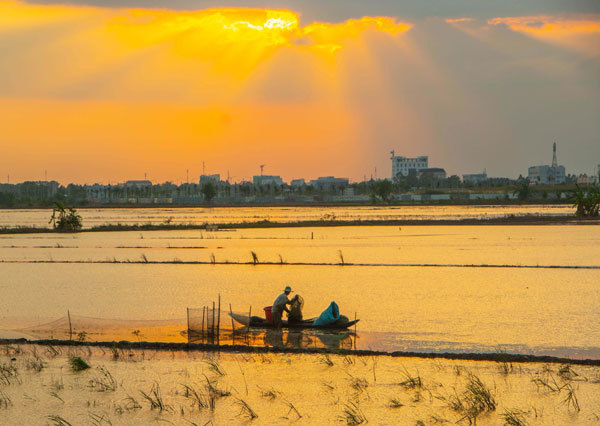 |
| Local communities in the Mekong Delta are facing bleak prospects as the fish stock is running out. VNA/VNS Photo Duy Khuong |
“Nowadays, the freshwater fish output doesn’t contribute much to the province’s economy, it is only a source of daily food and provides locals with a small extra income,” fishery director Dung said.
“An Giang has promoted the development of fish farming since 2000 to compensate for the loss of freshwater fish. Those affected the most by the fish loss are poor people in rural areas including ethnic minority groups.”
He said that one of the measures to mitigate the impacts of fish loss was to offer training for labourers in rural areas so they would not have to rely too much on freshwater fish catches and would be able to shift to other jobs.
Others think that it is important to hold the hydropower dams accountable.
“When the ecosystems are destroyed by hydropower projects, I don’t think governments should use public money to solve the problems,” said Director Deetes.
“It’s how we manage the shared water governance in the Mekong River that matters. It is crucial to have the dams regulated better, on how to make them release or hold water according to the season, respecting the environmental flows and the ecological nature downstream. That's the way to solve the root problem and prevent new destructive dams.”
Source: Vietnam News
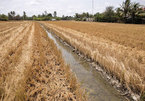
Water shortages, climate change linked to saline intrusion in Mekong Delta
The most severe saline intrusion - the movement of ocean saltwater into riverine freshwater - is said to occur in the Mekong Delta region from February 8 to 16, coinciding with the Tet (Lunar New Year) holiday,
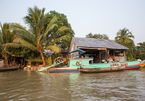
Three countries cooperate to audit water resources of Mekong River basin
The audit results of water resource management in the Mekong River basin show that the amount of water upstream of the river to the Cuu Long (Mekong Delta) has decreased sharply.